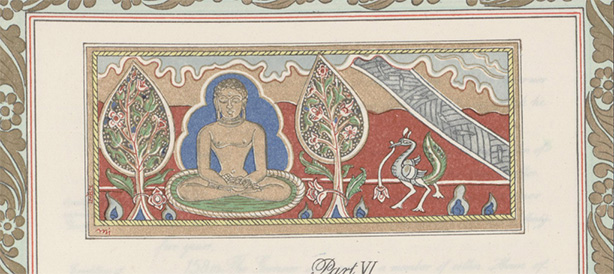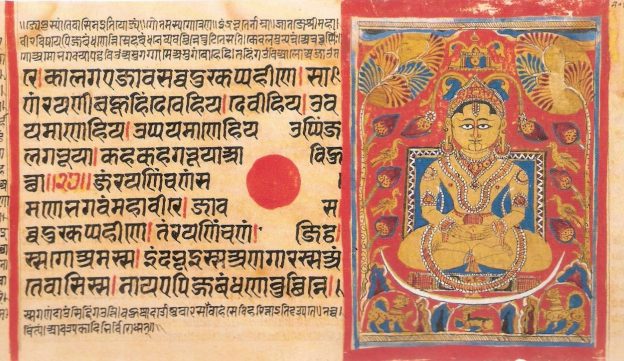Join Cultural Samvaad’s WhatsApp Community
Mahavira Swami was born in the spiritually fertile land of India in the 6th Century BCE and is considered to be the last among the 24 Tirthankaras in this time cycle as per the Jain faith. While in popular parlance he is referred to as the founder of Jainism, it has been concluded by scholars that the Jain faith predates him.
The story of Vardhman Mahavira’s life has two main tellings which emanate from the two major schools of Jainism – Digambara and Svetamabara. It is generally narrated with reference to the panch kalyanaks or 5 auspicious milestones which are the focal points of a Tirthankara’s life as per Jain tradition. They are:
- Garbha or Conception,
- Janma or Birth,
- Diksha or Renunciation,
- Kevala-jnana or Enlightenment and;
- Moksha or Liberation.
His janma kalyanak (i.e. his Birth) is celebrated as Mahavira Jayanti (falls in the months of March-April) while he attained moksha on the day of Deepawali (October-November).
Mahavira is probably the bravest apostle of non-violence who ever lived. His symbol is a lion and he is the chakravarti king, the wheel turning monarch, the peaceful conqueror whose unfathomable power can be experienced even 2,500 years after he roamed the earth. He was named Vardhamana by his parents, referred to as Shramana by many because he was tranquil and blissful and referred to as Mahavira by the devatas because he was unflinchingly steadfast in the face of hardships and dangers.
The Life of Mahavir
Garbha or Conception

As per the Svetambaras, Mahavira was first conceived in the womb of Devananda, a pious Brahmin woman and the wife of Brahman Rishabhadatta. She saw 14 auspicious and wondrous dreams that foretold his coming. At the behest of Shakra (Indra), Harinegameshi, his commander transferred Mahavira’s embryo to Trishala, the wife of the Ikshavaku Kshatriya King Siddhartha. On the night that Mahavira’s embryo was placed in her womb, she saw the same 14 dreams that Devananda had seen.
The Digambaras do not believe in the transfer of the embryo. They believe that Mahavira Swami directly descended into the womb of Trishala who saw 16 auspicious dreams which foretold his coming.
The wise interpreted the dreams as the coming of Mahavira – the bravest among the brave. It is stated in the Kalpasutra that the soothsayers and the wise told Kind Siddhartha:
“O King, the Queen has seen the most auspicious of dreams. They presage good fortune and foretell the birth of a son who will become a valiant hero and a great lord. He will be a Chakravartin with dominions extending in all four directions. But, it may also happen that he will become a great religious leader, a Tirthankara.”
It is said that he lay perfectly still in his mother’s womb so that she was not inconvenienced. When Trishala started worrying about the health of the foetus, he senses her anxiety and moved a bit to quell her fears.
Janma or Birth
Vardhamana Mahavira was born on the midnight 13th day of the waxing moon cycle in Chaitra in present day Vaishali. It is said that 56 dikkakumaris or celestial beings served as assistants to Queen Trishala and innumerable gods and goddesses showered silver, gold, jewels and ornaments, leaves, flowers and fruits, colours and perfumes to celebrate the coming of the Tirthankara. Shakra (Indra) and other celestial beings participated in his abhisheka or lustration rites that are performed at the time of birth.
As per the Digambara tradition, Vardhamana did not marry but the Shvetamabaras believe that he was married to Princess Yashoda.
Diksha or Renunciation
Mahavira was always cognisant of the spiritual path that beckoned him. He prepared for his renunciation for over a year by giving away all his worldly possessions.
On the 10th day in the dark half of Margashirsha, at the age of 30, Mahavira left his palace in Chandraprabha – his renunciation palanquin which was accompanied by a procession of devatas and human beings.
He took diksha and renounced the world by shedding his royal finery and plucking out his hair in 5 handfuls under an ashoka tree.
Mahavira practised severe austerities for the next 12 years and wandered from place to place facing multiple adversities.
Kevala-jnana or Enlightenment
At the age of 43, Mahavira achieved omniscience under a Sala tree on the bank of the River Rijubalika. He delivered his first sermon to devas, humans and animals from his Samavasarana or divine and brilliantly adorned preaching hall which was especially constructed for this momentous occasion by Indra and other devatas.

Mahavira Swami’s Teachings
Bhagwana Mahavira continued to preach for the next 30 years. He believed in the equality of all human beings and spoke against prevailing social injustices in his time.
The five principles (Pancha Sheel) Truth, Non-violence, Non-possession, Celibacy and Non-stealing form the bedrock of his timeless teachings. He also stressed on the seminal importance of the Ratnatraya or Three Jewels to attain liberation or moksha. The Three Jewels are:
- Samyak Darshan or Right Faith,
- Samyak Gyan or Right Knowledge and;
- Samyak Chartitra or Right Conduct
As per tradition, he had Mahavira Swami had 11 principal disciples or ‘Ganadharas’ who interpreted and spread his ‘Divyadhvani’ or Divine Word. He organised his followers into a fourfold order in his lifetime and the orders continue till date. The four orders are:
- Monastic Order of Sadhus (monks)
- Monastic Order of Sadhvis (nuns)
- Order of Shravakas (lay men)
- Order of Shravikas (lay women)
It is believed that the monastic orders had expanded to 14,000 monks and 36,000 nuns during his lifetime.

Moksha or Liberation
On the 15th night of the dark half of Kartika at the age of 72, Mahavira attained moksha and was set free from the fetters of life in Pawapuri in present day Bihar. The perfected soul (Siddha) ascended to Siddhashila, the region which is at the apex of the universe as per Jaina cosmology.

Mahavira Swami was one of India’s greatest spiritual leaders and a brave monarch who conquered the world through his non-violence. His spiritual power will hold sway till the end of our time.


Add comment